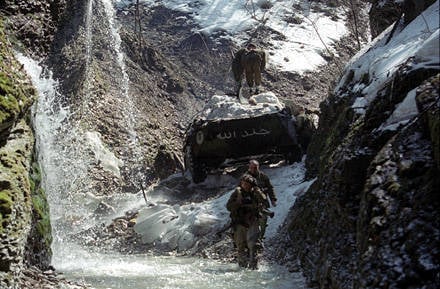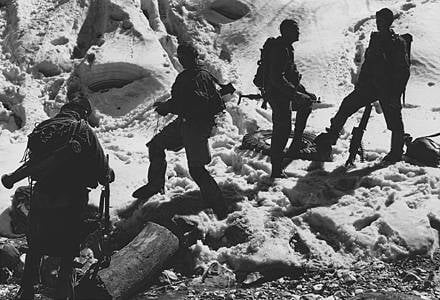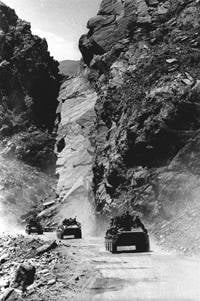Spetsnaz GRU: a story with a sequel

In addition, the task of the special forces included conducting reconnaissance of the concentration of enemy troops in its deep rear, conducting sabotage. As well as the organization of the partisan movement in the rear of the enemy.
However, in the 1953 year, due to the reduction of the USSR Armed Forces, only eleven separate special-purpose companies remained in the army.
But the situation in the world was developing in such a way that after a few years the special forces had to re-create: 29 August 1957 five separate special purpose battalions were formed, subordinate to the commander of military districts and military groups. To create them, the base and personnel of the disbanded companies were used.
It was also decided by 15 January 1958 of the year to form a second airborne school - in Tambov. But after the removal of Marshal GK Zhukov from the leadership of the Armed Forces of the USSR, the Tambov School for the specialized training of special forces officers was never created.
By the beginning of the 60 of the last century, the need for subdivisions and even special-purpose units was no longer in doubt. Directive of the General Staff of the Armed Forces of the USSR from 27 March 1962, the projects of the state teams of special forces for peacetime and wartime were developed. By the end of 1962, in Belarus, Far East, Transcaucasian, Kiev, Leningrad, Moscow, Odessa, Baltic, Prikarpatsky and Turkestan military districts scattered brigades of special forces were formed. This meant that part of the units in the brigade were deployed in peacetime state, that is, in a threatened period, they could be staffed with a registered squad. Several units in the brigade had only detachment commanders; all other officers, sergeants, and soldiers were in reserve.
In 1963, on the territory of the Byelorussian, Baltic and Leningrad military districts, GRU GSH conducted the first large-scale exercise, during which reconnaissance groups of army special forces actually threw themselves at the depth of their activities according to specific tasks.
Despite the successful work during the exercise, by the end of 1964, as a result of another reorganization, the army special forces lost three battalions and six companies.
At the same time, the leadership of the GRU GSH in 1968 returned to the idea of creating an educational institution that would prepare special purpose intelligence officers. As part of this program, the 9 Company was established at the Ryazan Airborne School, whose cadets, in addition to the main program, intensively studied foreign languages. Since 1970, language training has been included in the combat training program of special forces units. In August, 1977, as part of the intelligence department of the Military Academy. MV Frunze established training groups for the training of special forces officers.
As for the organization of combat training of special forces units directly, there was a lot to learn in practice. Based on the analysis and processing of the experience of the Great Patriotic War, instructions, methods, regulations, and survival reference books were published. Own experience had to turn out salty and sweat: stomp hundreds of kilometers, simulate situations, try to find the most optimal way out of them. Themselves invented and built a "scout path", tested special weapons, shoes and uniforms.
In Soviet times, there was a personal selection in the units of army special forces from among yesterday's taiga, hunters, athletes. Paramount importance was given to physical fitness: falling into? Special Forces guys had 5 – 6 first digits.
There were many educational subjects: political, special tactical, airborne, fire, military medical, automotive, sea, mountain training, mine-disruptive business, military topography, a foreign language, and much, much more. The program was thought out to the smallest detail. One item naturally complemented the other.
Knowledge of martial arts techniques added psychological confidence. In a real fight, a knife, a grenade, a stone and all available means were used. A psychologically trained warrior was superior to the enemy, so special attention was paid to ideological training. Whole institutions dealt with this issue. And no one doubted this: the special forces soldier had to clearly understand what he was fighting for.
Military topography is generally a sacred thing for the special forces. Owning it, you can significantly reduce the search time of the object, save power and money for the decisive moment. As part of the special tactical training, the actions of special-purpose groups and subunits in the deep rear of a potential enemy were practiced. The ability to silently make long marches, to mask and read the tracks, to organize the rest and suddenly appear where you are not expected.
At the same time, the first practical developments in composition and equipment of combat groups appeared, and the first tactical methods of their actions began to be accumulated. The number of reconnaissance groups was 14 – 15 people, with an increase could reach up to twenty. It consisted of a commander, his deputy, intelligence officers, radio telegraphists, arrows, miners, a doctor, and, if necessary, a translator. He was in the group and his cook, and a fighter who was throwing a grenade at 60 meters, and a sniper who, as they say, beat a squirrel in the eye ...

The first test of practical training of the Soviet special forces was Afghanistan.
To be precise, the “Afghan” period stories Soviet army special forces began before military convoys crossed the border of the neighboring state and rushed to its capital and main cities.
Its beginning can be considered 2 in May 1979, when the head of the GRU GSH, Army General Ivashutin assigned the task to Colonel Kolesnik to form an 154-th separate special-purpose squad, which included military equipment, and the total number of soldiers and officers was 520 people. Neither such weapons, nor such a state in the special forces before was not. In addition to the management and headquarters, the detachment consisted of four companies. The first was in service with the BMP-1, the second and third - the BTR-60pb. The fourth company was a company of weapons, which consisted of a platoon of AGS-17, a platoon of rocket infantry flame throwers "Lynx" and a platoon of sappers. Also in the squad included separate communications platoons, ZSU "Shilka", automobile and material support.
But the main oddity of the detachment was that soldiers, sergeants and officers of three nationalities were selected into it: Uzbeks, Turkmen and Tajiks. Therefore, the detachment was informally called the "Muslim battalion."
For the whole personnel of the battalion they sewed uniforms of the Afghan army, and also prepared legalization documents of the established pattern in the Afghan language. In November 1979, the detachment was flown to Bagram.
On December 13, the detachment was tasked to arrive in Kabul under its own power, ostensibly to enhance the protection of the Taj Beck palace. Everyone knows that the 27 of December squad together with the KGB special forces captured this palace ...
Since the beginning of hostilities, two separate special-purpose brigades operated in Afghanistan. The eastern part of the republic became the zone of responsibility of the 15 brigade, the western - the 22 brigade. A separate company of special forces operated in the Kabul area.
Among the main tasks assigned by the command of the 40 Army to the special forces were the destruction of caravans with weapons and ammunition, gangster formations, mercenary units, assistance to local security forces, and work on the training of informants.
The group of special forces is constantly increased. February 29 The 1980 squad was formed on the basis of the 12 Brigade of the Transcaucasian Military District, which had the same staffing structure as the 173. But he entered Afghanistan only in 154. From January 1984 of the year to October, the 1980 of the year, on the basis of the 1981 brigade, was formed the 22-th separate special forces unit, which entered Afghanistan in October of the 177 year. However, before 1981, he and the 154 squad were mainly involved in the protection of the pipeline and the mountain pass.
In 1984, the command of the Soviet troops decided to begin a more active use of special forces in Afghanistan. He was prompted to this decision by the expanding assistance coming to the Mujahideen from Iran and Pakistan, as well as the very effective work of the Kabul company.
To fight the insurgent caravans, the 154 squad was transferred to Jalalabad, and the 177 squadron — to Ghazni.
Since February, 1984, the 173-th squadron based in Kandahar, has begun to perform combat missions in Afghanistan.
The fact that the bet on the special forces was made correctly confirmed the results of his combat activities. In connection with this, in the autumn of 1984, the fourth squadron formed in the Kirovograd brigade arrived in Bagram. A few months later he was transferred to the Barracks. In the spring of 1985, three more army special forces units entered Afghanistan.
Each of them, like those who had entered Afghanistan before, had their own area of responsibility, and no one had a better idea of the situation in the area than the commander. Special Forces clearly knew their task and was ready to perform it at any time.
It was the special forces units that turned out to be the most adapted to combat in the conditions of mountain-desert terrain and showed the greatest combat effectiveness.
The 22-th separate special-purpose brigade was withdrawn from Afghanistan in August 1988, and the last divisions of the 15 brigade left “from behind the river” 15 in February 1989 of the year, covering the rearguard of the 40-th army.
IN THE PROCESS of the collapse of the Soviet Union, army special forces were forced to perform functions unusual for them. And after the beginning of the “parade of sovereign ties”, the associated division of territories and property suffered such losses that they did not even know during the nine years of the Afghan war.
 The end of the eightieth - the beginning of the ninetieth years was marked by mass social unrest, as well as by armed actions of militants of all kinds of separatist groups. The 173 squad was actively involved in establishing order in Baku, during the Ossetian-Ingush conflict, as well as in the events in Nagorno-Karabakh.
The end of the eightieth - the beginning of the ninetieth years was marked by mass social unrest, as well as by armed actions of militants of all kinds of separatist groups. The 173 squad was actively involved in establishing order in Baku, during the Ossetian-Ingush conflict, as well as in the events in Nagorno-Karabakh. In 1992, two detachments of the brigade of the Moscow Military District were sent to the Republic of Tajikistan to assist in maintaining constitutional order. In 1988 – 1989, three detachments of the 12 Specialized Brigade of the Transcaucasian Military District took part in establishing constitutional order in the Zakatala region of Azerbaijan and in Tbilisi; in 1991, they acted against the armed militias in Nagorno-Karabakh and North Ossetia.
But even the special forces were unable to save the once united great power.
As a result of the division of the Armed Forces of the USSR, special brigades were deployed to Ukraine, deployed in the Odessa, Kiev and Carpathian military districts. One team remained in Belarus. The brigade, a separate company and a special-purpose training regiment, which trained personnel for the warring units during the Afghan war, withdrew to Uzbekistan.
It should also be noted that this period was characterized by a drop in the level of combat training, and a lack of supply and equipment of special forces units and formations with weapons, military and other equipment. As, however, and the rest of the army and fleet...
In the Chechen conflict 1994 – 1996, Russian special forces took part from day one. Combined and separate detachments acted from the brigades of the Moscow, Siberian, North Caucasus, Ural, Trans-Baikal and Far Eastern military districts.
By the spring of 1995, the detachments from Chechnya were withdrawn, with the exception of a separate special-purpose detachment of the North Caucasian Military District, which fought until the end of hostilities and returned to the autumn of 1996.
Unfortunately, special purpose intelligence agencies, especially at the initial stage of hostilities, during the introduction of troops into Chechnya, were used as reconnaissance of units and formations of ground forces. This was a consequence of the low level of training of full-time intelligence units of these units. For the same reason, especially during the storming of Grozny, reconnaissance and special forces detachments were included in the assault groups, which led to unjustified losses. 1995 year can be considered the most tragic for the entire history of the army special forces, both the USSR and Russia.
Nevertheless, later, working independently, the special forces began to act, using the tactics inherent in it. The most common tactical technique was ambush. Often, special-purpose groups worked on intelligence information received from military counterintelligence agencies, the FSB and the Ministry of Internal Affairs. Field commanders were destroyed from ambushes, moving at night on high-traffic vehicles with little security.
In May 1995, special forces detachments of the brigade of the North Caucasus Military District took part in the operation to free the hostages in Budennovsk. In January, 1996, one of the detachments of the same brigade participated in the operation to free hostages in Pervomaisk. At the initial stage of the operation to free the village, a detachment of forty-seven people undertook a red herring to draw off the main forces of the militants. On? At the final stage, the detachment inflicted the most notable losses on the Raduev group that was breaking through, despite the multiple numerical superiority of the militants. For this fight, five special forces officers were awarded the title Hero of the Russian Federation, one of them - posthumously.
STILL in 1996, right after the signing of the Khasavyurt Agreement, it became clear that the conflict in the Caucasus would not end there. At the same time, there was a real danger of the spread of separatist ideas throughout the North Caucasus and other republics and regions of Russia. Dagestan was the most susceptible to the ideas of Wahhabism, where the secret services of Saudi Arabia and a number of other Islamic states began active work in the early nineties. It was obvious to analysts of the General Staff that it was Dagestan that would become the first territory that the Wahhabis would try to seize from Russia to create an independent Islamic state in the North Caucasus.
It was in connection with this that at the beginning of 1998 from the 22-th brigade in Kaspiysk a separate special-purpose unit departed. A few months later he was replaced by another. So, replacing each other, up to August 1999, their fighters conducted reconnaissance in the areas bordering Chechnya, studied the system of guarding and alerting the administrative border from the Chechen side, tracked the movement and sales of "left" oil products, which came in large numbers from Chechnya, together with the bodies of the Ministry of Internal Affairs and the Federal Security Service (FSB) identified the arms trade channels
Before the outbreak of hostilities, the special forces provided the troops with reconnaissance data, revealing defenses and positions of militants.
Subsequently, the grouping of army special forces was reinforced by consolidated and separate detachments, which came from virtually all military districts. The command of the 22 Brigade supervised their actions.
After the defeat of the main centers of resistance in Dagestan, the troops moved into Chechnya. The special forces detachments entered with them. At the initial stage of the counterterrorist operation, they mainly conducted reconnaissance in the interests of the advancing troops. None of the combined-arms commander moved his troops forward until it received the go-ahead from the commander of the special forces group. This, in particular, explains the small, compared with the first Chechen campaign, the loss of federal troops during the advance to Grozny.
The commandos took the most direct part in collecting intelligence information about the militant group that defended Grozny. Almost all of it was opened with a fairly high degree of reliability.
Subsequently, the special forces also proceeded to their tactics of search-ambush actions and making raids on the discovered bases of the militants. This was especially characteristic of operations in the foothills and in mountainous areas, when the special forces fully benefited from the experience gained in Afghanistan.
According to experts and most of the combatants in Chechnya, no one is better in the second Chechen campaign than the GRU special forces.
A direct confirmation of this fact was the assignment in April 2001 of the 22 th separate brigade of special purpose to the rank of the Guard. She became the first and still remains the only unit in the Russian Armed Forces, awarded this honor after the end of the Second World War.
- Igor WIND
- http://www.bratishka.ru"rel =" nofollow ">http://www.bratishka.ru
Information